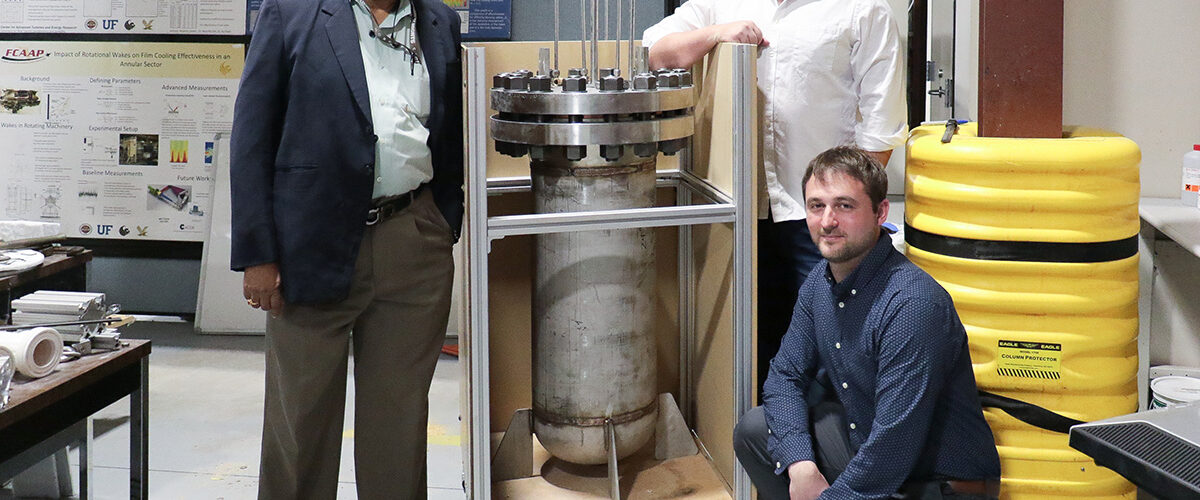Fans of Back to the Future may remember the term “flux capacitor” as a fictional device that allows for time travel. That device still doesn’t exist, but a University of Central Florida storage technology does use a different type of flux capacitor developed by NASA.
While trying to find a way to store renewable energy (like solar and wind) and then use it when needed, UCF Pegasus Professor Jayanta Kapat and researchers Marcel Otto and Ladislav Vesely found that NASA’s Cryogenic Flux Capacitor (CFC) could be part of the solution.
The UCF team recently invented a way to cost-efficiently convert excess renewable energy to hydrogen and oxygen and store it long-term — days, weeks or even months. Later, when the energy is needed, it’s reconverted and added to the electrical grid. That on-demand capability enables power companies to meet and balance the energy needs of a community not just from day to day, but from season to season.
Kapat, who directs the UCF Center for Advanced Turbomachinery and Energy Research, says that lithium battery systems are fine for short periods — a few hours to a day.
“But suppose a hurricane comes and causes a blackout for a week?” he says. “Or it’s a very bad winter out West and they do not have a lot of renewable resources?”
“It’s not just about having the morning to night kind of storage, but it is from one season to another season kind of storage too,” he says. “Summer could be a time when you’ve got excess energy, like solar, and winter could be a time when you need the energy.”
Blending Renewable Energy for the Electrical Grid
Designed to help resolve that kind of mismatch between demand and available power, the UCF invention (called an H2/O2 Direct-fired sCO2 Power System) blends the use of renewables to keep electrical grids going.
“We use that excess electricity from renewables to electrolyze water and make hydrogen and oxygen, and then we store them separately,” Kapat says.
Later, when electricity is needed, the UCF technology combines the stored hydrogen and oxygen in a combustion chamber. The combination forms water, which heats and mixes with supercritical carbon dioxide (sCO2). Part of the closed-loop power system, sCO2 is a nontoxic, nonflammable, low-cost working fluid used to run turbine systems that generate electricity.
Kapat says the technology is a closed system without any nitrogen or air present and recycles the water from the combustion, storing it in a reservoir for the next cycle.
With NASA’s CFCs as the storage mechanism, the UCF system can house the hydrogen and oxygen separately using conduits and pressure valves until they are needed. The CFCs contain retention material that adsorbs the hydrogen and oxygen for storage. They keep the gases at liquid-like densities, applying moderate pressures and temperatures without the need for liquefaction.
“So, the energy requirement as compared to liquid hydrogen weighs less over time, making it more attractive for long-term storage,” he says.
Safeguarding the Environment
One of the benefits of the technology over other systems is that it does not emit harmful nitrogen oxides (NOx) since air is not included in the hydrogen-oxygen combustion process. The pollutants are known for causing acid rain, smog and greenhouse gases that damage the ozone layer.
A second environmental plus is that the system can be installed and operated in an area with little or no water sources.
“We do not have to worry about where to get the water,” Kapat says. “So, there’s no need to constantly use groundwater or water from sources like rivers and lakes.”
Vesely says another benefit of the technology is its compact size.
“You don’t need much of a footprint to build the system,” he says.
Looking Beyond Power Grids
Otto says in addition to traditional power grids, the invention could be used for other applications.
“I could see using this technology as a backup system for a data center, a hospital or some facility that needs to be available 24/7,” Otto says. “Or to reduce the carbon footprint to replace a diesel generator.”
In agreement, Kapat notes that the power generation market is changing drastically, and the idea of a large central power grid supplied by a utility company may not exist in 20 years as it does today.
For example, he says that instead of one system powering hundreds of thousands of homes, there could be a group of smaller systems each powering a few thousand for a local community.
“By doing this in distributed systems, the whole structure becomes more resilient and not everybody gets affected,” he says. “Thus, a smaller portion of people get affected because everybody else can live off their own energy storage system.”
This format also offers more control, he says.
In the case of an upcoming hurricane, an area might determine that severe weather could cause a maximum outage of one week. In preparation, the area would split the water and store the resulting hydrogen and oxygen.
“If it ends up being enough for four weeks, then you know that you can survive for four weeks,” Kapat says.
The invention supports the storage needs of other industries, such as aviation, too.
“Planes cannot be directly powered by solar or electricity — we need the fuel,” Kapat says. “Hydrogen can be used there too, where we convert renewables into a storable chemical and then use it.”
As for future plans, Kapat says the team is continuing to research ways to optimize the storage. They are also promoting the technology to the U.S. Department of Energy and working to secure funding for more testing.
For more information about the invention, view the technology sheet.
Technology Available for License
To learn more about the research team’s work and additional potential licensing or sponsored research opportunities, contact Andrea Adkins (andrea.adkins@ucf.edu) at (407) 823.0138.
